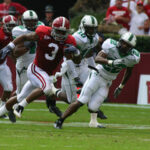Introduction
Company W has developed a new formula for one of their snack foods that is cheaper than the formula they currently use. They want to see if their consumers can tell the difference in the old formula and the new formula. In order to conclude on this statistical data needs to be gathered from consumers in regards to the two snack food formulas. This presentation will list some qualitative attributes to the snack food that Company W may want to ask their consumers regarding the snack food formulas so that a conclusion can be made on the differences in the two, and some qualitative attributes for measuring the differences in the two formulas will also be detailed. The difference in nominal and ordinal data will be explained, and the difference between interval and ratio data will be discussed. In addition, the difference between a population and a sample will be noted, as well as examples will be given on possible populations for testing the formulas of the snack food.
Slide 3
Qualitative Attributes
Qualitative attributes are associated with the biased quality of a thing, such as feeling, tasting, or seeing a picture of the two different formulas regarding the snack food so that a conclusion can be made on the differences in the two. Qualitative aspects are theoretical in that they do not require measurement because the reality of it is that they can only be approximately rated (BusinessDictionary, n.d.). In regards to qualitative questions that Company W can ask their consumers regarding the formulas of the snack food the first would be associated with tasting the two formulas. The question would be, “does sample A (current formula) taste like sample B (new formula)?” The next question would be associated with feeling the two snack foods to see if the textures of the two formulas are the same. And the last thing to do with the consumers related to the qualitative characteristics is to show them a picture of the two different formulas to see if the two snack foods differ in appearance. The knowledge of the qualitative aspects of the formulas will be achieved through observing and connecting the understanding of the fundamental snack food to come to a conclusion on which formula is preferred by consumers (BusinessDictionary, n.d.).
Slide 4
Nominal and Ordinal Data
Qualitative data can be nominal or ordinal. Nominal data is when there is no natural ordering of categories related to the snack food formulas; examples of this might be in relation to the question of tasting formula A and formula B to see if they differ in taste. Company W could rank this question by randomly asking both male and females if the formulas taste the same are differ in taste, and then a rating scale can be utilized to tell if the majority of males or females say that the formulas taste the same or differ. On the other hand, ordinal data is categories that may be ordered regarding the snack food formulas. An example of this could be the question of feeling or looking at the picture of the two snack food formulas and having consumers rate their opinion on a scale of 1-5. For instance, do the snack foods feel different (strongly agree, agree, neutral, disagree, and strongly disagree), and the same can be done with the picture of the two different snack food formulas and ratings can be done on a 1-5 scale so that a conclusion can be made as to whether the two formulas taste the same. Both nominal and ordinal data can be put on a preferred rating scale so that Company W will have knowledge of which formula consumers favor or if one formula tastes the same or differs from the other (CTU Online, 2011).
Slide 5
Quantitative Attributes
Quantitative attributes are associated with an unbiased quality of a thing that is measurable, such as softness or hardness in relation to the snack food when measuring the two formulas. The data related to quantitative is numerically measured to conclude on a given topic or question. Quantitative data that is said to be discrete is measurements of whole numbers or things, such as amount of individuals in one household, however if the quantitative data is incessant then the measurements can take on values between two given rates, such as weight of an item (Summarizing and Presenting Data, 2011). Some quantitative attributes that scientists may want to measure regarding the snack food would be the weight of one snack food formula versus the other snack food formula, and what age group or gender prefers one snack food formula over the other.
Slide 6
Interval and Ratio Data
Interval and ratio data are two types of quantitative data because they measure quantities of an item. An interval variable is a measurement where the difference among the two values being compared is important. Data that is interval is calculated along a level in which the value of each variable is central from one another which permits the space among the two variables to be equal to one another in some way. On the other hand, a ratio variable does have all the properties of an interval variable, but it also has a plain explanation of zero to ensure that the ratio scale has meaning. The measurement of ratio data is done on an absolute scale so that figures can be evaluated compounded to one another. Also, because both interval and ratio data can be measured on a scale they are sometimes called scale data (Changing Minds, 2011).
Slide 7
Population and Sample Difference
A population in statistics is the entire area that the researcher is obtaining information from. It includes all elements of an identified group that information is being gathered from in order to make factual driven decisions on the subject at hand. A sample, on the other hand, is a proportion of the population that the researcher is in fact going to study. In this sense, in order for preconception to be minimized it is important for the researcher to have a sample that will represent the entire area of the population. With that being said the main concern of a researcher studying a population is to categorize the characteristics of the subject being examined, and the main concern of the researcher studying a sample is to make assumptions regarding the uniqueness of the population in which the sample was taken from (Carroll, n.d.). Some possible populations for testing the snack food formula would be selecting consumers who live in different regions to come to a better conclusion on if the formulas taste the same or are different, and testing the population of age among consumers to see if different age groups think that the formulas taste the same or taste different.
Slide 8
Conclusion
It is vitally important for a researcher to completely avoid any bias when conducting research. This is because when a researcher permits bias to be included in their research they only show one opinion regarding the topic at hand. Furthermore, avoiding bias when conducting research will encourage the actual goal of the research, encourage the ideals that are crucial to working mutually, hold the researcher answerable to the community, aid in building the support of the community, and endorse a mixture of other significant ethical and community standards. Also, if bias is avoided when conducting research the results of the examination will bring about an enhanced suggestion as to what the participants really feel, and one conclusion over another will not be favored (Resnik, 2010).
Slide 9
References
BusinessDictionary. (n.d.). Definition: Qualitative. Retrieved from http://www.businessdictionary.com/definition/qualitative.html
Carroll, S. (n.d.). What is the difference between a population and a sample? Retrieved from http://www.dissertation-statistics.com/population-sample.html
Changing Minds. (2011). Types of data. Retrieved from http://changingminds.org/explanations/research/measurement/types_data.htm
CTU Online. (2011). Applied Managerial Decision Making. Phase 1 course material [text]. Retrieved from https://campus.ctuonline.edu/pages/MainFrame.aspx?ContentFrame=/Home/Pages/Default.aspx
Resnik, D. (2010). What is ethics in research & why is it important? Retrieved from http://www.niehs.nih.gov/research/resources/bioethics/whatis.cfm
Summarizing and Presenting Data. (2011). Types of variable. Retrieved from http://surfstat.anu.edu.au/surfstat-home/1-1-1.html



